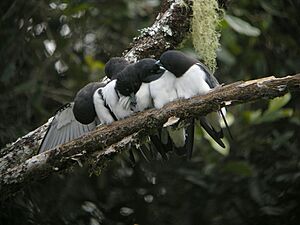Great woodswallow facts for kids
Quick facts for kids Great woodswallow |
|
|---|---|
 |
|
| Conservation status | |
| Scientific classification | |
| Genus: |
Artamus
|
| Species: |
maximus
|
The great woodswallow is a fascinating bird found in New Guinea. It's also called the greater woodswallow or giant woodswallow. This bird belongs to the family Artamidae.
As its name suggests, it is the biggest bird in the Artamus group. Great woodswallows are about 20 centimeters (8 inches) long. They usually weigh around 61 grams (2.2 ounces). These birds look a lot like the white-breasted woodswallow. However, you can tell them apart by their darker black feathers on top. They also have a black patch under their throat.
Contents
Where Great Woodswallows Live
The great woodswallow lives in tropical montane forests. These are moist forests found in mountains. They prefer clearings with dead trees, especially tall ones. These trees often stick out above the main forest canopy.
Adapting to Their Home
Even though they have always been common, these birds have adapted well. They thrive even when humans change the landscape. You can often find them near towns in the Highlands. Places like Mount Hagen and Goroka are good examples.
Altitude and Temperature
Great woodswallows can live very high up. Some are found as high as 3,000 meters (9,800 feet). But they are most common between 1,000 meters (3,300 feet) and 2,500 meters (8,200 feet). Unlike some other birds, they do not lower their body temperature. This helps them stay warm on cool nights.
Behaviour and Life Cycle
The great woodswallow is a fast-flying bird. It mainly eats large flying insects. This makes it an insectivore. It catches its food while flying in the air.
Soaring and Hunting
This bird is known for soaring on air currents. It is thought to be the smallest bird that regularly soars over long distances. It also uses its feet to hold and eat its insect prey.
Social Life and Breeding
Great woodswallows are very social birds. They fly in groups of up to twenty birds. They also move around their mountain forest homes. It is common to see them preening each other. This is called allopreening. They often do this in tight groups on small posts.
They usually breed between August and December. Their nests are flat platforms of grass or twigs. They build these nests in tree holes or stumps. These nests are usually higher off the ground than those of other woodswallow species.
Great woodswallows are cooperative breeders. This means that young adults often stay with their parents. They help raise the new chicks for several years.



